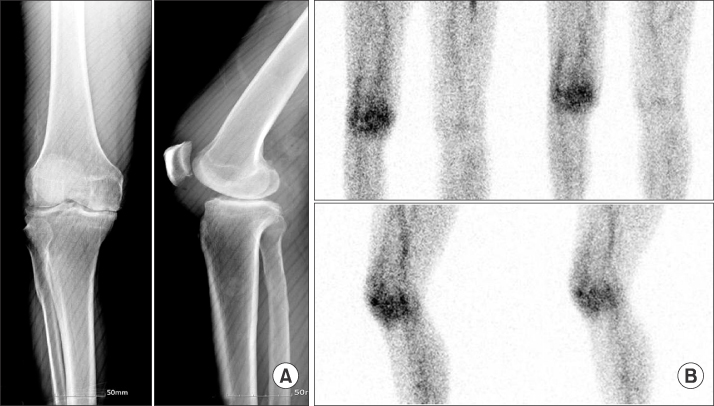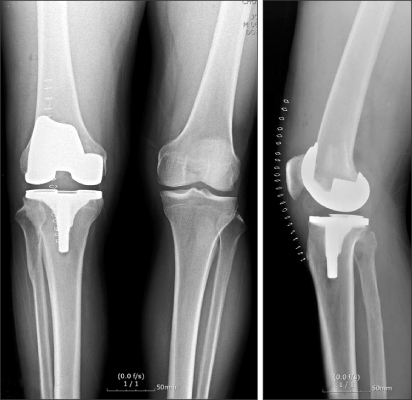J Korean Orthop Assoc.
2015 Feb;50(1):55-59. 10.4055/jkoa.2015.50.1.55.
Compartment Syndrome of the Thigh Following Manipulation to Treat Knee Stiffness after Total Knee Arthroplasty
- Affiliations
-
- 1Department of Orthopedic Surgery, Research Institute of Clinical Medicine, Chonbuk National University Medical School, Jeonju, Korea. wsi1205@naver.com
- KMID: 2106739
- DOI: http://doi.org/10.4055/jkoa.2015.50.1.55
Abstract
- A 67-year-old man developed compartment syndrome of the thigh following manipulation for treatment of knee stiffness after a total knee arthroplasty. Three months earlier, he had undergone arthroscopic synovectomies twice for treatment of septic arthritis in the same leg. Manipulation for treatment of stiffness concomitant with periarticular inflammation is a possible risk factor of compartment syndrome.
Keyword
MeSH Terms
Figure
Reference
-
1. Fitzsimmons SE, Vazquez EA, Bronson MJ. How to treat the stiff total knee arthroplasty?: a systematic review. Clin Orthop Relat Res. 2010; 468:1096–1106.
Article2. Keating EM, Ritter MA, Harty LD, et al. Manipulation after total knee arthroplasty. J Bone Joint Surg Am. 2007; 89:282–286.
Article3. Smith EL, Banerjee SB, Bono JV. Supracondylar femur fracture after knee manipulation: a report of 3 cases. Orthopedics. 2009; 32:18.
Article4. Rorabeck CH, Castle GS, Hardie R, Logan J. Compartmental pressure measurements: an experimental investigation using the slit catheter. J Trauma. 1981; 21:446–449.5. Boody AR, Wongworawat MD. Accuracy in the measurement of compartment pressures: a comparison of three commonly used devices. J Bone Joint Surg Am. 2005; 87:2415–2422.
Article6. Yercan HS, Sugun TS, Bussiere C, Ait Si Selmi T, Davies A, Neyret P. Stiffness after total knee arthroplasty: prevalence, management and outcomes. Knee. 2006; 13:111–117.
Article7. Su EP, Su SL, Della Valle AG. Stiffness after TKR: how to avoid repeat surgery. Orthopedics. 2010; 33:658.
Article8. Bawa HS, Wera GD, Kraay MJ, Marcus RE, Goldberg VM. Predictors of range of motion in patients undergoing manipulation after TKA. Clin Orthop Relat Res. 2013; 471:258–263.
Article9. Hailer NP, Adalberth G, Nilsson OS. Compartment syndrome of the calf following total knee arthroplasty: a case report of a highly unusual complication. Acta Orthop. 2007; 78:293–295.10. Nadeem RD, Clift BA, Martindale JP, Hadden WA, Ritchie IK. Acute compartment syndrome of the thigh after joint replacement with anticoagulation. J Bone Joint Surg Br. 1998; 80:866–868.
Article11. Kort NP, van Raay JJ, van Horn JR. Compartment syndrome and popliteal vascular injury complicating unicompartmental knee arthroplasty. J Arthroplasty. 2007; 22:472–476.
Article12. Cates HE, Schmidt JM. Closed manipulation after total knee arthroplasty: outcome and affecting variables. Orthopedics. 2009; 32:398.
Article
- Full Text Links
- Actions
-
Cited
- CITED
-
- Close
- Share
- Similar articles
-
- Diabetes mellitus does not increase the risk of knee stiffness after total knee arthroplasty: a meta-analysis of 7 studies including 246 053 cases
- The Role of Early Routine Manipulation in Total Knee Arthroplasty
- Compartment Syndrome Following Total Knee Arthroplasty: Clinical Results of Late Fasciotomy
- Manipulation under Anesthesia for Stiffness after Total Knee Arthroplasty
- Early Manipulation for Flexion Limitation after Total Knee Arthroplasty




